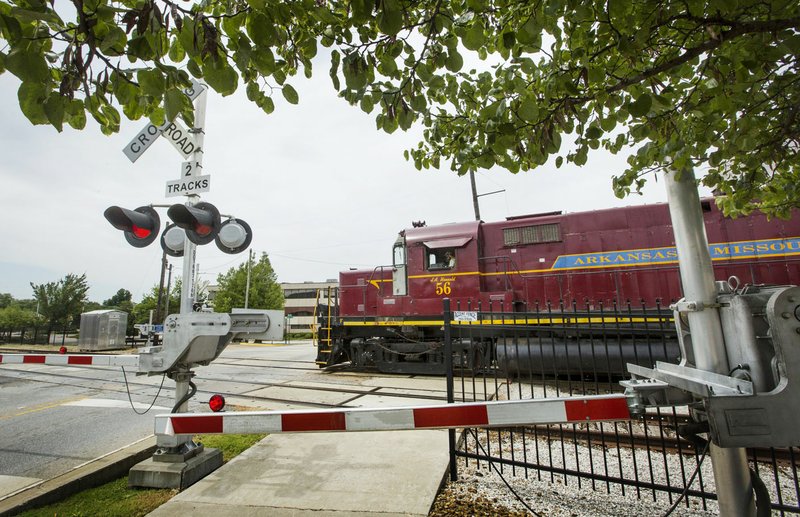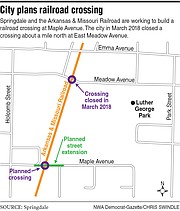SPRINGDALE -- City officials learned railroads don't always run on a two-way track.
The officials thought they granted a favor when the city closed a railroad-street crossing in the burgeoning downtown district.
They hoped for one in return.
But when city officials asked the Arkansas & Missouri Railroad to open a new crossing a block south on Maple Avenue, they found the city held a one-way ticket.
The City Council on Tuesday night approved $486,860 to build a new crossing of the tracks at Maple Avenue -- and to pay for other conditions the railroad imposed.
City Council member Brian Powell hesitated before he cast his vote to accept the agreement. He said he doesn't like the railroad's actions, which he likened to bullying.
"My holdup was the railroad," he said. "The agreement was that we give them everything. Plus the maintenance agreement? Plus the liability?"
SAFETY FIRST
The new crossing will link an extension of East Maple Avenue from Holcombe Street to Park Street. The city plans to spend $2.5 million -- which includes the cost of the crossing -- on the project. The money for both will come from the $92.7 million bond program for streets approved by voters in 2108, said Wyman Morgan, director of finance and administration for the city.
The city's also on the hook for a yearly $13,500 maintenance fee and continuing liability insurance, for which the premiums haven't been set, said Ernest Cate, the city attorney.
The railroad in March 2018 granted the city's request to close a street crossing at Meadow Avenue, just a block south of the crossing at Emma Avenue and a block north of the planned Maple crossing. The closing helped control traffic around Tyson Foods' new offices, Morgan said.
The new crossing and extension of Maple will provide drivers, hikers and bikers another way to access the downtown area and the soon-to-be-renovated Luther George Park.
Maple lies two blocks south of Emma Avenue, the center of the city's revitalization effort. The eastern end of the extended Maple will almost border the south end of the park.
The city recorded 15,919 cars traveled through the intersection of Maple and Holcombe from July 15 to July 29, said Ryan Carr, a senior project manager in the city's engineering department. The report counted 225 bicycles traveling through the intersection during the same time period.
The new railroad crossing will open access to the eastern part of town for the Fire Department, Mayor Doug Sprouse said. Closing the Meadow crossing left the trucks from Station No. 1 on Holcombe Street without a good way to respond to calls, said Fire Chief Mike Irwin.
Response times for crews in Station No. 1 increased by 12 to 13 seconds from 2017 to 2018, when Meadow was closed in March. But Irwin couldn't directly attribute the extended times to the closed crossing.
"I really wanted to vote no," Powell continued. "But I know how badly this crossing is needed -- and that's just for the fire and police service. The No. 1 thing the city is responsible for is to ensure the safety of its residents, and to do that, the infrastructure must be set."
The crossing at Maple will be much safer than the one at Meadow, Sprouse said.
The Meadow crossing featured no signals and is immediately south of the railroad's excursion train depot and railroad museum. The buildings blocked vision of the tracks for motorists traveling from the west.
"It's going to have a fully functional safety apparatus with flashing lights to signal a crossing," said Ron Sparks, describing the modern crossing planned at Maple. Sparks is the chief of the local railroad's police department. The gate will include two arms, which will block vehicle traffic from both directions, and four arms to stop pedestrians from crossing the tracks, Baldwin added.
OFF TRACK
Sprouse said he thought opening a new crossing would come easily, kind of a return good gesture for closing the Meadow crossing. But the railroad management changed after the gentlemen's agreement and their message wasn't so gentle.
Railroad officials didn't return multiple calls or questions submitted via email.
When the city asked to open the Maple crossing, railroad officials countered with conditions -- one being the city pay to build the crossing.
Conditions were listed in letters between Cate and Joel Johnson of Hayes, Johnson & Conley, Fort Smith attorneys representing the railroad. They included fencing from the Meadow site to the Maple crossing, closing the crossing at Caudle Avenue and maintenance at some existing crossings.
"Their lawyers were pretty firm with what they wanted," Cate said. "But we talked and eventually agreed that the other things were not as pressing as this Maple crossing."
"We asked them to concentrate on getting this Meadow project immediately before us, so we could get that crossing going," Sprouse said. The other issues will be considered later, Cate said.
The railroad also asked the city to close Hewitt Street, which serves as the eastern boundary of the railroad company's headquarters and shop, which front Emma. The railroad and city soon will announce a project to expand the railroad facilities and tie them into the downtown revitalization project, Cate said.
Fayetteville worked with the Arkansas & Missouri to open a crossing on Van Asche Drive at North Gregg Road in 2006. Chris Brown, engineer for Fayetteville, said the city had to pay for installation of the crossing and insurance against accidents during the construction and into perpetuity.
At Van Asche, the Razorback Greenway crosses under the railroad tracks, and railroad officials wanted to be relieved of liability in case of an accident. Brown gave the example of something falling off the tracks and hitting someone using the trail.
The city continues negotiation with the railroad to open two more crossings, both on the Fulbright Expressway, Brown said. This time, the railroad asks the city for perpetual maintenance costs and help in maintaining the crossing gates.
"Basically, when we want to put in new railroad crossings, we expect to pay for it," he said. The city's recent bond issue included costs for the crossings.
"Crossings of a railroad are a liability in terms of safety and maintenance," Brown continued. "They are detrimental to their operation, so they don't go out about looking for new crossings."
The railroad runs through Fayetteville, Springdale and Rogers from south to north, so the tracks are barriers to east-west travel, Brown noted. But as his city's footprint continues to expand, more crossings are needed.
Just like crossings of Interstate 49 are limited, so are crossing of the tracks, Brown said.
"And they may or may not permit ours."
HEAD OF STEAM
"The railroads hold a lot of the cards," Sprouse said. "I guess back when railroads were being built 100 years ago, they got a lot of good legislation passed."
Railroads and cities must abide by regulations for railroad construction developed by the Arkansas Department of Transportation. The state guidelines also include requirements of the federal Department of Transportation.
Brad Baldwin, the director of engineering and public works for Springdale, said the railroad right of way trumps all others. In fact, the railroad can turn away the city's first responders from incidents on the rails. The Arkansas & Missouri police force investigates all incidents with automobiles on its tracks, he said.
When the railroad came to town in the 1800s and 1900s, the town fathers wanted to keep the owners of the railroad happy, so a lot of regulations favored the railroad, said Pat McKnight, a park ranger at the Steamtown National Historic Park in Scranton, Pa. The park is a railroad museum operating historic rail yard equipment, locomotives and train cars.
"The railroad was the biggest business in town and brought commerce," McKnight said. "Hundreds of thousands of employees worked on the railroad. Like any business, the railroad supported different politicians. And historically, any railroad accidents turned out in favor of the railroad."
"Actually, it's a matter of order," said Peter Hansen of Winter Park, Fla., railroad historian and the editor of Railroad History. The Railway and Locomotive Historical Society has printed the journal and its successors since 1921.
"The railroad was there first," Hansen said.
Brown agreed, noting when Fayetteville's roads were created, most of the railroad infrastructure already existed. Cate referred to a 1914 plat map in his office that shows the railroad.
"And it's a matter of priority," Hansen continued. "It's simple physics: It's harder to stop a train at a crossing than a car."
A train traveling at 30 mph might take a mile to stop depending on its size and weight, according to the Highway-Rail Grade Crossing Resource Guide published by the Federal Railroad Administration.
The Arkansas & Missouri reported 13 incidents at it crossings of highways and railroads from 2015 to today, according to the railroad administration. The railroad also counts four fatalities in the same time period.
The railroad runs over 140 miles of track running from the Arkansas River Valley to southern Missouri.
Arkansas was among the top 13 states in number of interactions with trains and pedestrians or drivers in 2018. The state saw 51 collisions, with 10 deaths and 16 injuries, according to Operation Lifesaver, a national rail safety organization.
"You never want to lose a life in any business," McKnight said. "Accidents cost money and slow you down, that's the mercenary part of it."
"For the railroad, the best crossing is no crossing," Hansen said.
NW News on 09/01/2019

